Weald and Navestock Wildside Walk - Healthy Life Essex
Home » Articles » Outdoor Life » Countryside in Essex » Country Walking » Weald and Navestock Wildside Walk
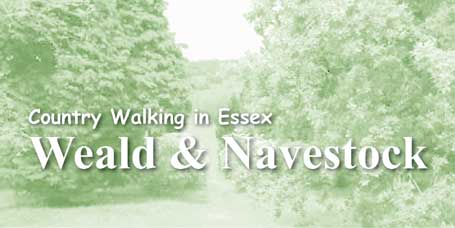
For an area so close to London, the high quality landscape and quiet country lanes are a complete joy. Enjoy a day out exploring the jewel in the crown of Essex Country Parks and its surrounding countryside.
Weald Country Park
Weald Country Park has a well documented history going as far back as 1063. The land was given to the Abbots at Waltham Abbey who began the process of shaping the landscape. It was during the 12th century when deer were introduced that the open landscape was formed by constant grazing, 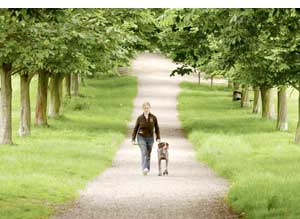 preventing the growth of new trees. Since then, deer have been part of the park up to the Second World War when they escaped through a breach in the perimeter fence. The recently introduced fallow deer will help to retain this traditional landscape.
preventing the growth of new trees. Since then, deer have been part of the park up to the Second World War when they escaped through a breach in the perimeter fence. The recently introduced fallow deer will help to retain this traditional landscape.
During the 18th century the large scale landscaping began with the construction of the lakes and woodlands.
The mixture of formal landscapes and deer pastures must make it one of the best Country Parks in Essex and even on the busiest day many quiet spots can be found all around the park.
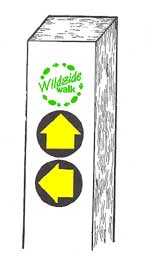 Walks are usually ‘Waymarked’, but be aware that some waymarks are now in dis-repair or even missing. They are found on special posts, stiles, gates and some fingerposts. The posts are usually painted white so that they can be seen from a distance (when needing to cross large fields etc this can be very useful. Tip: Binoculars can be handy to have when looking for the white posts.)
Walks are usually ‘Waymarked’, but be aware that some waymarks are now in dis-repair or even missing. They are found on special posts, stiles, gates and some fingerposts. The posts are usually painted white so that they can be seen from a distance (when needing to cross large fields etc this can be very useful. Tip: Binoculars can be handy to have when looking for the white posts.)
Wildside walk plaques are bright green and unique to Wildside walks in Essex.
Yellow ‘Directional Arrows’ usually on circular disks indicate the direction you should follow. (Path junctions are more complicated! Each arrow indicates an alternative route, so use the map to make your choice.)
Three different types of directional arrow are used:
Plain Yellow: used on ‘official’ public footpaths
Yellow Arrow with Courtesy Footpath: A small number of paths are not ‘official’ public rights of way. Most courtesy paths are in Nature Reserves and are generally provided courtesy of the landowner.
Plain Blue: Used on ‘official’ bridleways. Only found on the Bicknacre walk – look out for horses and cyclists.

Open a larger scale, printable copy of this map in Adobe pdf format![]()
Points of interest along the way
Pilgrim’s Lane
As the name suggests, Pilgrim’s Lane is an old thoroughfare for pilgrims on their way to Canterbury in Kent. It is now a quiet bridleway and a haven for wildflowers and birds.
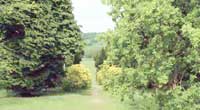 Weald Country Park
Weald Country Park
In Weald Country Park the woodlands are a mixture of conifers and hardwoods, gradually opening out into old deer parkland with pollarded trees. These ‘pollarded’ trees would have been cut at a height of about 10 feet from the ground. This provided a source of wood which was kept well out of reach of browsing deer and cattle.
Oak Trees
The lonely oak trees scattered among the arable fields would have been removed to accommodate larger farm machinery.
Princes Road
Princes Road is an old lane, deep and winding with steep banks and sides and is part of a network which connected villages, hamlets and scattered farms. They are becoming increasingly rare due to road improvements.
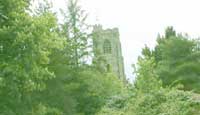 Black rabbits
Black rabbits
Look out for the famous black rabbits of Weald..
Original fields
Many of the original small fields remain bounded by hedges.
Weald Country Park Visitor Centre
The visitor centre is a renovated barn and inside you will find information about the Country Park and Harold the ‘concrete tree’ (the ranger’s answer to tree vandals!). Gifts and light refreshments are also available.
 Deer paddock
Deer paddock
In the deer paddock you will see a herd of fallow deer, a reminder of Weald’s rich former past when the park and surrounding countryside was a royal hunting forest for the Kings of England..
The Mores
This woodland is owned by the Woodland Trust, a charity committee set up to safeguard as many woodlands as possible. The first half of this woodland is dominated by birch which is particularly good for insects and fungi. Look out for the bracket fungus especially on dead or dying trees. Across the boardwalk the woodland is ancient and is dominated by hornbeam coppice.
Note the weird and wonderful shapes of the trees and lack of light penetrating the woodland floor. This is largely due to neglect of the coppice management. However it is hoped that this traditional management will once again be reintroduced to the benefit of the wildlife..
The Lakes
The lakes were created by hand in the 18th century mainly for ornamental purposes. Today they are home for a variety of wildlife including the great crested grebe whose feathers were eagerly sought after by Victorian ladies for their hats. This inevitably led to a dramatic decline in the bird’s population until another group of ladies formed a bird protection organisation which became the Royal Society for the Protection of Birds (RSPB).
|
Distance and time taken Going Transport Habitat types |
Ordnance Survey Map Parking Refreshments Dogs |
Photographs Courtesy of Public Rights of Way Dept, Essex County Council
![]() Produced in conjunction with Essex County Council
Produced in conjunction with Essex County Council
Maps reproduced by kind permission of
the Public Rights of Way Dept, Essex County Council
www.essexcc.gov.uk/prow
